Items tagged with 'Ecovative Design'
Growing a chair
Green Island-based Ecovative is one of the Capital Region's most interesting companies. For the past decade it's been developing ways of using mycelium -- mushroom roots -- to "grow" all sorts of materials that can replace things like styrofoam or leather.
In the clip embedded above, the company shows an experiment in making a chair using the mushroom root tech. It's interesting to watch how the process works -- and, also, that something not-quite working is part of the path.
Ecovative's mushroom root tech is now being used to make (not) leather

This is wild: Ecovative has partnered with a company in California to use its mushroom root tech to make a material that looks remarkably like leather.
That company -- Bolt Threads -- now has a Kickstarter for the first consumer product (tote bags) made with the not-leather, which it's calling Mylo. (That's one of the bags above in the photo.) The Kickstarter went live this week and is almost halfway to its $40,000 goal.
From a Bolt Threads FAQ:
We use corn stalks and supplemental nutrients to feed and grow our mycelium. We precisely control growth conditions like temperature and humidity to encourage the mycelium to grow upward and self-assemble into an organized mat of interconnected cells. Their connections give the material strength. We then use a natural tanning process and compress the mat to be as thin or thick as we'd like the final material to be. At this point the mycelium is no longer growing. The final step is to imprint any desired pattern, which gives us the final material. ...
Our friends at Ecovative pioneered this mycelium fabrication technology, which literally grew out of the great work they've been doing in creating soft flexible foams. We were blown away, and thrilled when they agreed to allow us to help develop it into a commercially viable new material. We've established a long-term partnership with Ecovative to optimize this technology and put processes in place to produce commercial-ready Mylo™ material and bring products to market that consumers will love.
As you know, Ecovative was started by two RPI grads about a decade ago and it's now based in Green Island. It uses what are essentially mushroom roots to bind leftover agricultural materials into various environmentally-friendly packing materials and fiber boards. The tech has gotten the company international attention, and it's been used in all sorts of projects.
photo via Bolt Threads Kickstarter
Grow light
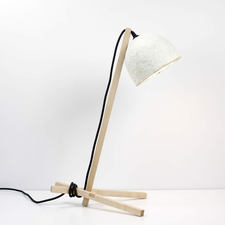 Something different for your desk: The Green Island-based mushroom-material company Ecovative now has a grow-it-yourself lamp kit.
Something different for your desk: The Green Island-based mushroom-material company Ecovative now has a grow-it-yourself lamp kit.
It comes with a stand for the lamp, the electrical components, mushroom material, and a form for growing the lamp shade. It's $85 and available online. (And apparently it works if even you don't exactly follow the directions.)
If you're feeling even more DIY, the company also sells the grow-it-yourself mushroom stock on its own by the bag for $20.
As you know, Ecovative was started by two RPI grads about a decade ago and it's now based in Green Island. It uses what are essentially mushroom roots to bind leftover agricultural materials into various environmentally-friendly packing materials and fiber boards. The tech has gotten the company international attention, and it's been used in all sorts of projects.
photo: Ecovative
Grow-it-yourself ornaments

Most people probably have at least a few homemade holiday ornaments. But how about home-grown ornaments.
Ecovate -- the Green Island-based company -- is selling a grow-it-yourself kit for growing holiday ornaments out of the company's mushroom material. "Six plastic ornaments filled with mushrooms that you grow yourself. You rehydrate the mushroom material, then fill the ornaments, and let them grow."
The kits are $30. You have to order before December 14 to have them by Christmas, according to the website.
The ornament kits are just one of the items in Ecovative's online store. You can also buy a general-use bag of the company's mushroom material. There's also a small line of furniture that the company's recently starting making/growing.
As you know, Ecovative was started by two RPI grads about a decade ago and it's now based in Green Island. It uses what are essentially mushroom roots to bind leftover agricultural materials into various environmentally-friendly packing materials and fiber boards.
photo via Ecovative
Ecovative GIY
 Ecovative -- the Green Island company growing polystyrene-replacement products from mushrooms -- says it will soon be offering the material for people to grow their own structures. Blurbage:
Ecovative -- the Green Island company growing polystyrene-replacement products from mushrooms -- says it will soon be offering the material for people to grow their own structures. Blurbage:
The "Grow It Yourself" (GIY) product enables designers, artists, educators, and innovators to grow their own creations with Mushroom® Materials, just like we do at Ecovative. We hope to inspire the use of healthy, ultra-rapidly renewable, compostable materials in all kinds of products and projects.
The GIY kit includes bags of living Mushroom® Material, which is essentially the same raw material that we use to grow Mushroom® Packaging and other products. GIY growers can use this material to make their own new and exciting creations. In cases where a GIY customer has created a new product that needs to be produced at scale, Ecovative can help. Our production facility in Green Island, NY can replicate designs with a high degree of consistency and quality control.
Ecovative says the first batches of material will be distributed in early September -- there's a sign-up form at that link above. The kits will be $19.99 + shipping.
The Hy-Fi tower
Ecovative's material has been getting (even more) attention lately because of structure that recently opened at MoMA's satellite location in Long Island City. The Hy-Fi tower was designed by David Benjamin, from architecture firm The Living, and makes use of 10,000 bricks grown from Ecovative's product. Benjamin created a prototype of the bricks himself with a few bags mushroom material he got at Ecovative during a visit to the company. Here's a recent interview with Benjamin about the tower and Ecovative on WNYC.
Earlier on AOA: Ecovative in the New Yorker
photo: Ecovative
Growing a building, brick by brick

Like spreading mycelia, Ecovative's presence branches out: The Green Island-based company's "grown" building material will be used to make bricks, and those bricks will be used this summer for structures at MoMA's PS 1 facility in Queens. It's a collaboration with the architecture firm The Living.
From a MoMA press release:
The winning project, Hy-Fi, opens at MoMA PS1 in Long Island City in late June. Using biological technologies combined with cutting-edge computation and engineering to create new building materials, The Living will use a new method of bio-design, resulting in a structure that is 100% organic material. The structure temporarily diverts the natural carbon cycle to produce a building that grows out of nothing but earth and returns to nothing but earth--with almost no waste, no energy needs, and no carbon emissions. This approach offers a new vision for society's approach to physical objects and the built environment. ...
Hy-Fi is a circular tower of organic and reflective bricks, which were designed to combine the unique properties of two new materials. The organic bricks are produced through an innovative combination of corn stalks (that otherwise have no value) and specially-developed living root structures, a process that was invented by Ecovative, an innovative company that The Living is collaborating with. The reflective bricks are produced through the custom-forming of a new daylighting mirror film invented by 3M. The reflective bricks are used as growing trays for the organic bricks, and then they are incorporated into the final construction before being shipped back to 3M for use in further research. The organic bricks are arranged at the bottom of the structure and the reflective bricks are arranged at the top to bounce light down on the towers and the ground. The structure inverts the logic of load-bearing brick construction and creates a gravity-defying effect--instead of being thick and dense at the bottom, it is thin and porous at the bottom. The structure is calibrated to create a cool micro-climate in the summer by drawing in cool air at the bottom and pushing out hot air at the top. The structure creates mesmerizing light effects on its interior walls through reflected caustic patterns.
That's a pic on the planned structure above. The whole thing sounds very Ecovative.
[via Gizmodo]
(Thanks, AddiesDad!)
rendering: The Living
DIY tiny mushroom house
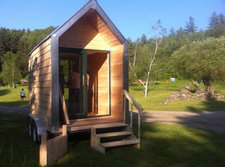 A few months back we mentioned that Green Island based Ecovative Design was "growing" a tiny house using its mushroom tech. Well, the house is now finished.
A few months back we mentioned that Green Island based Ecovative Design was "growing" a tiny house using its mushroom tech. Well, the house is now finished.
Ecovative is using the house as a test of ideas as it works toward getting into producing building materials. That idea has been bubbling for a while, but the company temporarily held off on it while it pursued the creation of packaging material (and hooked up with companies such as Dell and Steelcase). The overall aim for both types of products is to provide a eco-friendly alternative to styrofoam.
Now Ecovative is selling DIY kits to create mushroom-based insulation, or an entire tiny mushroom house. The insulation material is $8 per cubic foot. And the basic kit for the house is $8000 (the deluxe kit is $12,000).
Earlier and elsewhere:
+ Fast Company: This Tiny House Was Grown From Mushrooms
+ Ecovative in the New Yorker
photo: Ecovative
Ecovative in the New Yorker
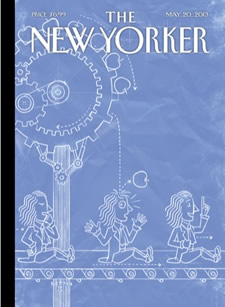 The new issue of the New Yorker include a good article about Ecovative by Ian Frazier. Here's a clip:
The new issue of the New Yorker include a good article about Ecovative by Ian Frazier. Here's a clip:
Gavin McIntyre, the co-inventor of a process that grows all-natural substitutes for plastic from the tissue of mushrooms, holds a pen or pencil in an unusual way. Gripping it between two fingers of his right hand, he moves his arm across the paper so that his wrist grazes the inscribed line; because of this, he uses pens with ink that doesn't smear. When he draws an explanatory diagram of the chitin molecule--chitin is the principal component of mycelium, the white, rootlike vegetative structure of fungi--he bends over his work, then looks up earnestly to see if his hearer has understood. The gesture makes him appear younger than his age, which is twenty-eight. He wears glasses and has straight black hair, dark eyes, and several piercings, with studs in his lip and ears.
The other co-inventor, Eben Bayer, won't be twenty-eight until June. Bayer is almost six-five, and often assumes the benign expression of a large and friendly older brother. His hair is brown, short, and spiky, his face is long, and his self-effacing manner hides the grand ambitions that people who come from small towns (Bayer grew up in South Royalton, in central Vermont) sometimes have. When he says, of the company that he and McIntyre founded, "We want to be the Dow or DuPont of this century," he is serious. He is their company's C.E.O., McIntyre its Chief Scientist. People with money and influence have bet that they will succeed.
As you know, Ecovative is based in Green Island -- and both McIntyre and Bayer are RPI alumni.
The article highlight both of the founders' backgrounds, along with the key role of RPI professor Burt Swersey in encouraging them, and mycologist Sue Van Hook in helping to grow Ecovative's library of fungus. And it also includes a bunch of interesting bits about the company's beginnings, tech, and plans (fungal resistors for mobile phones?).
More than anything, though, Frazier elegantly lays out Ecovative's ideas alongside the history of Dow Chemical -- the producer of Styrofoam -- and explains why Ecovative could be such an important, industry-altering company.
Earlier on AOA: A whole bunch of items about Ecovative
Grow house
 In progress at Ecovative, the Green Island-based startup that creates packaging and insulation from mushrooms: a small house that's growing its own walls. Blurbage:
In progress at Ecovative, the Green Island-based startup that creates packaging and insulation from mushrooms: a small house that's growing its own walls. Blurbage:
We spent 5 years focused on protective packaging. Today it's a huge success, being used to package everything from servers to surf boards. Now we're looking ahead to what's next, and it may be time to return to our roots and dive back into building materials.
This project is a bold experiment to build and grow a house with Mushroom Insulation. We could have started by just building a simple wall assembly and subjecting it to lab tests. And we'll surely be doing that soon. But we thought that starting by building a whole tiny house would lead to more learning (possibly through failure) faster than anything else we could do. Also, we all just think tiny houses are really cool.
Basically, they've built a frame and are letting the mycelium (sort of like mushroom roots) fill in the gaps by bonding together agricultural waste. It's pitched as a environmentally friendly alternative to polystyrene insulation.
The company's set up a site with frequent updates tracking the construction and progress.
photo: Ecovative Design
Ecovative in Wired
 There's a profile of Green Island startup Ecovative in the February issue of Wired -- the article is now online via Wired UK (which explains the Britishisms in the linked story above).
There's a profile of Green Island startup Ecovative in the February issue of Wired -- the article is now online via Wired UK (which explains the Britishisms in the linked story above).
You've read some of it before, but there are some interesting new (to us) bits that touch on how good ideas come about, and what it takes to foster them. Also: Eben Bayer and Gavin McIntyre may be the first Wired profile subjects who grew their own headline.
We've posted a bunch about Ecovative, in part because it's an interesting local story with a fun angle (Packaging! Made from mushroom roots! By two good-looking nerdy guys!). But the company also has big potential. The polystyrene packaging business is a $20 billion a year industry (according to the Wired article) -- and Ecovative is looking to disrupt it with a product it says costs the same and doesn't harm the environment. That's an enormous opportunity. And it's growing from the ground up here.
Sure, it's not a multi-billion dollar chip fab or sprawling nanotech campus. But maybe it could be, someday. Upstate New York benefited greatly over the last century thanks to companies that created new industries -- names such as Kodak, Xerox and GE (many of which are now faded). If this part of the country ever finds that sort of prosperity again, it most likely will involve people and companies that have disruptive, industry-creating or shifting ideas.
Is it likely that Ecovative ever becomes as big as Kodak (once was) or GE? The odds are extraordinarily long. But all those companies started somewhere. Why not a warehouse in Green Island?
thumbnail: Chris Crisman / Wired
Winners in Capital Region's non-win: lofts, mushroom packaging, Troy riverfront
 The Cuomo administration announced the winners of the Regional Economic Development Council competition today -- and the Capital Region did not win. The "best plan" awards went to Western New York, Central New York, the North Country, and Long Island -- they all got about $100 million in funding.
The Cuomo administration announced the winners of the Regional Economic Development Council competition today -- and the Capital Region did not win. The "best plan" awards went to Western New York, Central New York, the North Country, and Long Island -- they all got about $100 million in funding.
But the Capital Region wasn't exactly a loser, either. The region scored $62.7 million in grants. So, call it a non-winner.
A total of 88 projects in this region are getting funding. Some of it looks pork-ish (of course, all in the eye of the beholder). There are handful of grants that caught our eye. The full list, with highlights, after the jump.
Big new customer for Ecovative Design

Dude, you're getting a Dell.
Dell, the giant computer company, announced today that it is running a pilot program that will use the mushroom-based packaging made by Ecovative Design, the Green Island based startup.
Ecovative has developed a styrofoam replacement material called EcoCradle -- or, as the company points out, it's grown EcoCradle. The packaging material is composed of agricultural byproducts and the thread-like roots of mushrooms called mycelia. And, unlike styrofoam, it's compostable and biodegradable.
Dell says it will be testing EcoCradle in shipments for one of its servers. In 2009, the company started using packaging made from bamboo.
Ecovative already had a deal with office furniture company Steelcase to supply to packaging material. And it's also developed an insulation material based on the same technology.
Ecovative was founded by Eben Bayer and Gavin McIntyre, both RPI grads. The company's gotten a lot of attention -- it was even name-checked on CSI:NY. Last year it was named a "technology pioneer" by the World Economic Forum.
Earlier on AOA:
+ A (very cool) fungus grows in Troy
+ and a whole bunch of other items about Ecovative
photo: Ecovative Design
Inside Ecovative
A recent story on the public television show Nightly Business Report included an interesting extended peek inside Ecovative's packing-material-from-mushrooms factory in Green Island:
And, please, don't harm the fungus.
A bowl (made) of mushrooms
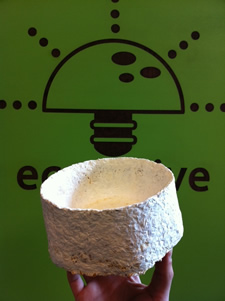 Ecovative, the Green Island-based startup that's developing a styrofoam replacement material made from mycelia (fungus roots), introduced its first consumer product today: the Myco-Bowl.
Ecovative, the Green Island-based startup that's developing a styrofoam replacement material made from mycelia (fungus roots), introduced its first consumer product today: the Myco-Bowl.
It sounds like the uses for the Myco-Bowl might be a bit limited:
Keep in mind that these bowls are made of natural materials. Appearance may vary slightly from bowl to bowl. You can fill them with water or plant things in them, but this will cause them to biodegrade. We don't recommend eating out of these.
If that doesn't float your boat, there are also Myco-Ducks.
OK, so consumer products might be the killer app here. Ecovative has developed packaging material for an office furniture company. And it's also developed an insulation material.
Ecovative was founded by Eben Bayer and Gavin McIntyre, both RPI grads. The company's gotten a lot of attention -- it was even name-checked on CSI:NY. Earlier this year it was named a "technology pioneer" by the World Economic Forum.
Earlier on AOA: a whole bunch of stuff about Ecovative
photo via Ecovative
Ecovative's Eben Bayer at TED Global
Check it out: Eben Bayer's TED Global talk is online.
Bayer is one of the co-founders of Ecovative Design, a Green Island-based startup that uses fungi to produce eco-friendly replacements for styrofoam. His talk -- which he gave this past summer in Oxford, England -- covers the problem with styrofoam packaging and how mushrooms can be used to grow replacement material. There's video of Ecovative's manufacturing process.
Chitinous polymers. Hot.
Ecovative was recently named a "technology pioneer" by the World Economic Forum.
Bayer and Gavin McIntyre, both RPI grads, started Ecovative in 2007.
(Thanks, Jessica R!)
Earlier on AOA: a whole bunch of stuff about Ecovative
Ecovative called a "technology pioneer"

Ecovative's environmentally-friendly packaging material.
Ecovate Design, the Green Island-based startup, has been named a "Technology Pioneer" for 2011 by the World Economic Forum (you know, the Davos people). From the WEF brochure:
Over US$ 100 billion dollars of environmentally harmful foams are used each year, depleting finite fossil fuel reserves and causing serious environmental impact during production and disposal. Ecovative's technology has the potential to eliminate a significant amount of environmentally harmful foams, including the expanded polystyrene used worldwide in packaging, automobiles, building construction and consumer goods.
Ecovative has developed packaging and insulation that made with seed husks and mushroom roots. The two founders, Eben Bayer and Gavin McIntyre, are RPI grads. The company's gotten a lot of attention -- it was even name-checked on CSI:NY.
From 2008 on AOA: A (very cool) fungus grows in Troy
photo: Ecovative Design
"The Death of Styrofoam?"
 There's an interesting profile of Green Island startup Ecovative Design and its founders Eben Bayer and Gavin McIntyre in The L Magazine. From the article by Robert Tumas:
There's an interesting profile of Green Island startup Ecovative Design and its founders Eben Bayer and Gavin McIntyre in The L Magazine. From the article by Robert Tumas:
As the van corners sharply onto the interstate, a 10-inch piece of what looks like molded off-white Styrofoam, with curious pieces of brown bark and particulates laced throughout, slides across the dashboard and comes to a rest on the beat-up glove box in front of me. I pick it up and turn it around in my hands; it's a little rough, but otherwise feels exactly like Styrofoam. "Sorry," Eben says, taking it off my hands and tossing it in the back of the car, "It's everywhere." The material in question is called Ecocradle, an invention of Eben and Gavin's, and it just might save the world. This may sound like a big claim for something that looks like a dirty piece of old Styrofoam, but that's the point; Ecocradle could very well spell the end of old-fashioned Styrofoam, and all its attendant environmental evils.
The piece includes a bunch of details about Bayer and McIntyre, the founding of the company, the non-response from the Styrofoam industry and Ecovative's plans for the future.
Definitely worth reading through.
Earlier on AOA: a whole bunch of items about Ecovative
CSI:Green Island
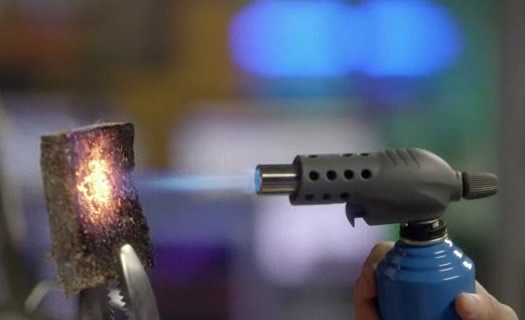
Can mushroom insulation help catch the Compass Killer? (cue ominous music)
This is funny/cool/awesome: Ecovative's Greensulate material (you know, the insulation made from mushrooms) showed up as evidence on CSI:NY last night. Here's the episode -- the segment name-checking Ecovative and Greensulate is at 25:20.
It's a pretty great spot for the product. The characters talk about how it's fire-resistant and eco-friendly. But there's a mystery -- how did "cutting-edge insulation get on our vic?" Hmm.
Ecovative, which was started by two RPI grads and is now based in Green Island, has been been getting all sorts of attention recently. Founders Eben Bayer and Gavin McIntyre were on CNN in September. Bayer spoke at spoke at the nerd-chic PopTech conference in October (here's video). And now they're helping Gary Sinise catch bad guys.
Earlier on AOA: A (very cool) fungus grows in Troy
[via @katerbirch]
screen grab: CBS
More attention for Ecovative
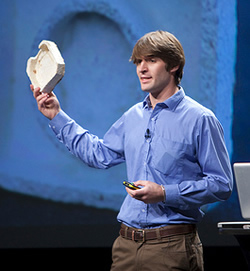 Eben Bayer -- one of the founders of the Green Island-based startup Ecovative -- spoke yesterday at the PopTech conference in Maine. (PopTech, in its own words: "a global community of cutting-edge leaders, thinkers, and doers from many different disciplines, who come together to explore the social impact of new technologies.")
Eben Bayer -- one of the founders of the Green Island-based startup Ecovative -- spoke yesterday at the PopTech conference in Maine. (PopTech, in its own words: "a global community of cutting-edge leaders, thinkers, and doers from many different disciplines, who come together to explore the social impact of new technologies.")
Bayer is one of PopTech's "social innovation" fellows this year. He talked yesterday about the environmental impact of polystyrene -- Ecovative makes an eco-friendly polystyrene replacement using mushrooms.
As part of an awareness/marketing campaign, Ecovative is asking people to send in pictures of expanded polystyrene.
Earlier on AOA:
+ Fungus is the new punk rock
+ Award-winning fungus
+ A (very cool) fungus grows in Troy
photo: PopTech
Fungus is the new punk rock
Eben Bayer and Gavin McIntyre -- the two founders of local green tech startup Ecovative Design -- were featured on CNN recently as part of the channel's "Young People Who Rock" segment:
Bayer and McIntyre started Ecovative, which grows eco-friendly insulation using mushrooms, based on work they did as students at RPI. During the CNN segment they cited Burt Swersey, one of their Rensselaer professors, for urging them and other classmates to go out and invent things that solve needs, not wants.
The company recently expanded into new space in Green Island.
(Thanks, Jessica!)
Earlier on AOA:
+ Award-winning fungus
+ A (very cool) fungus grows in Troy
A (very cool) fungus grows in Troy
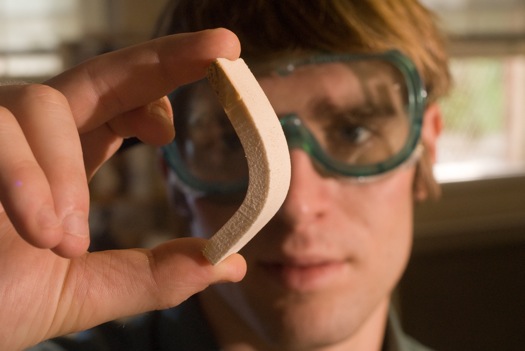
Eben Bayer with a piece of Greensulate.
OK, so you've probably heard all about locavorism and the effort to buy locally-sourced, but what about taking that philosophy and applying it to industrialism?
That's exactly what RPI grads Eben Bayer and Gavin McIntyre are trying to do with their company Ecovative Design.
... said KGB about Drawing: What's something that brought you joy this year?